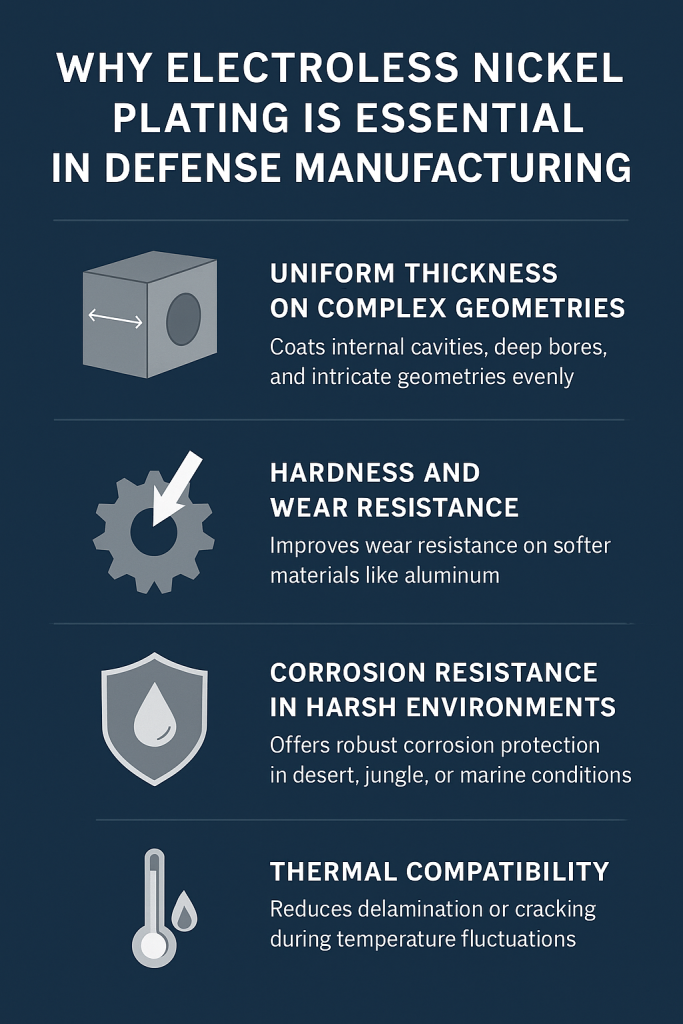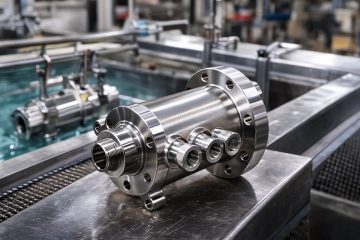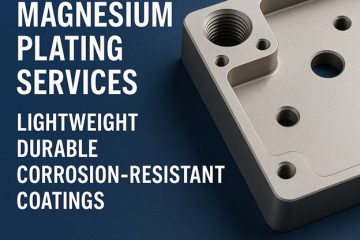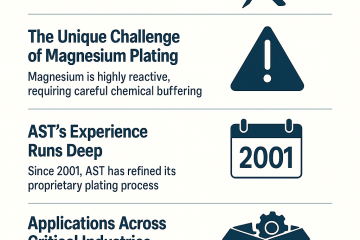Why Electroless Nickel Plating is Essential in Defense Manufacturing

A Coating That Goes Beyond Protection
The defense and aerospace industries require components made with high precision to tight tolerances. Every component must perform flawlessly, often under extreme conditions. That’s why electroless nickel plating is frequently the coating of choice for mission-critical parts. Often referred to as an “engineering coating,” electroless nickel offers both corrosion protection and precision to plus or minus 0.0001” of thickness.
___________________________________________________________________
Why Defense Engineers Choose Electroless Nickel
1. Uniform Thickness on Complex Geometries
Unlike electrolytic plating, which relies on electrical current, electroless nickel is deposited through a chemical process. This means quality plating can be applied to internal cavities, deep bores, and intricate geometries. Clearly, this meets the needs of critical components in weapons systems and flight hardware.
2. Hardness and Wear Resistance
Formulations that vary the amount of phosphorus in the electroless nickel deposit can increase hardness and improve corrosion resistance. Higher deposit hardness can improve wear resistance, especially for on softer materials like aluminum, titanium, and stainless steel. A thin layer of EN, even just a few ten thousandths of an inch, is frequently enough to extend the lifespan of a part that is subject to friction or repeated part-to-part contact.
3. Corrosion Resistance in Harsh Environments
High phosphorus (10% plus) electroless nickel offers robust corrosion resistance. In the field, this translates into equipment that performs reliably in harsh environments like desert heat, humid jungles, or salt-laden marine air.
4. Thermal Compatibility
The coefficient of thermal expansion for electroless nickel aligns well with materials like aluminum and stainless steel, reducing the risk of delamination or cracking during temperature fluctuations.
5. Specialty Applications
Electroless nickel is effective for a wide variety of applications but EN can be enhanced to meet even greater challenges. Materials like PTFE and boron-nitride can be added to EN plating tanks to add lubricity and even greater hardness than EN alone. AST’s Pen-Tuf® (EN with PTFE) has a coefficient of friction of 0.2 or less. With post-plate heat treatment, Boron-Nitride Electroless Nickel offers similar lubricity characteristics as Pen-Tuf® but can offer deposit hardness of 60-65 Rockwell. This is very similar to hard chrome plating without the potential environmental impact. ___________________________________________________________________
Solving Real-World Military Challenges
In one defense program, AST plated thousands of magnesium chassis and covers for portable computing systems carried by soldiers. Due to magnesium’s lightweight nature and poor corrosion resistance, electroless nickel provided the ideal protective layer without adding unnecessary weight. Electrolytic plating would not have been feasible for this application due to coverage limitations, making electroless nickel a very practical solution.
___________________________________________________________________
Specification-Driven, Quality-Focused
AST isn’t just “running the process.” We verify compliance with specifications through rigorous testing. Monthly testing is performed to meet the requirements of key specifications including AMS 2404, ASTM B733, AMS2454, and others.
Whether the specification calls for corrosion protection, improved hardness, or co-deposited materials for special applications, AST validates its work to exacting performance requirements.
AST is ISO 9001:2015 certified and ITAR registered. The Sam.gov Cage Code is 1TK95.
AST’s reputation is built on doing more than what’s required. If you’re designing components for mission-critical systems, you need a plating partner who understands the spec, and proves it.
___________________________________________________________________
Looking Ahead: Increased Demand on the Horizon
As U.S. weapons inventories are replenished and new defense initiatives gain traction, the need for precision surface finishing is expected to rise. Electroless nickel plating will continue to play a pivotal role in delivering lightweight, corrosion-resistant components that perform in the field.
Looking for a defense-compliant partner with proven electroless nickel capabilities?
Contact AST today to request a quote or discuss your specifications.


